 |
Art & Architecture
Vanguard Art against the Church
Cunha Alvarenga
Taking into account what we have already analyzed about modern art in both its figurative and abstract currents, we can affirm that modern art was created to serve as an instrument for the Revolution to combat Catholic doctrine in aesthetics.
In addition to the proofs we have already presented about the artistic works produced by these currents, we have many testimonies of the partisans of modern art. They begin by harshly attacking the “artistic tyranny” of the medievals, which they call “the old dogmatic praxis” destroyed by the Renaissance. Then, they reveal a clear anti-Catholic character in the multiple stages of this aesthetic revolution.
‘We want to gratify our instincts’
Osório Cesar, for example, a 20th century author and partisan of modern art in Brazil, makes this religion-centered evaluation of a branch of the movement: “Futurism was born in an epoch of mesmerizing dynamism. No one believes in dogmas any more. The Christian faith disappeared and its slavery no longer torments us. The art of the masters likewise no longer captivates us. It does not satisfy us.
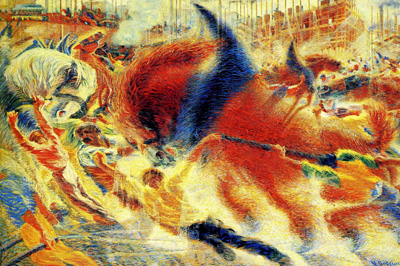
The City Rises by Boccioni express revolt against the past |
“Classic literature bothers us greatly as well. We want to gratify our instincts. We do not want to understand. We long for new sensations. And why is this? Because we are constantly moved by our primal ancestral influences, a millennial primitive man sleeps and dreams inside each one of us.
"We have seen our first desires, which in our childhood were suppressed by moral prejudices, move to the subconscious and now be expressed by the vanguard artists.” (1)
Portuguese poet Fernando Pessoa (1885-1935), defining his religious position, reveals the underpinning of modern art: “[I am] a Gnostic Christian and, therefore, completely opposed to all organized churches, above all the Church of Rome. I am faithful … to the secret tradition of Christianity, which is intimately connected with the secret tradition of Israel (the holy Kabala) and the occult core of Freemasonry.” (2)
For similar reasons, we find occult “gurus” such as Max Jacob, Apollinaire, Madame Blavatsky, Annie Besant, Leadbeater, etc. behind the principal currents of modern art.
Progressivism supported by leaders of Modern Art
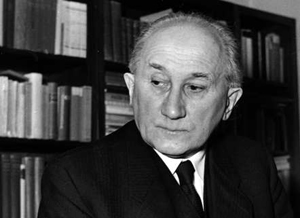
Progressivist priest Romano Guardini abandoned clerical garb |
Similar Gnostic interests led Oswaldo de Andrade, one of the founders of Brazilian modern art, to confess his sympathies for the leftist liturgical currents that had infiltrated the Church. He affirmed that Catholicism was adjusting itself, “returning, so to speak, to its pro-socialist position.” What interests him most, in the movement of renewal in Catholicism, however, is the persona of the German early progressivist priest and scholar, Romano Guardini. De Andrade states:
“This leader attributes an enormous weight to the cult, rites and liturgy, and this seems to me of capital importance since he seeks to destroy the reactionary nucleus of moralizing clericalism. In The Spirit of the Liturgy, Guardini goes so far as to place cult above Ethics. In dealing with man’s vocation to believe and adore, Romano Guardini resolves questions that used to make sin a problem of conscience for the majority of believers. While Barth commands us to believe, Guardini invites us to adore. For me these are the only paths we can find today to a renewal of Christianity inside the realm of utopia and dream, not outside the social sphere.” (3)
The occult inspires branches of modern art
Behind modern art is a group that holds in its hands the strings of all the puppet artists, both those who are initiated into its shadowy secrets and the naïve who are dragged along by this crazed con game.
We leave aside here Expressionism and other 19th century art currents to look at the principal branches of the so-called modern art vanguard at the beginning of the 20th century. Along with the return to Primitivism, the magical art of the African and Oceania witchdoctors, Cubism surfaced.
From it came two currents: on the one hand, Futurism, Rayonism and Abstractionism, on the other hand, Dadaism and Surrealism. There were also less important variants of Cubism such as the Tubularism of Fernand Léger with its figures of steely flesh that underscored his fascination with the machine, and the Purism of Le Corbusier with its emphasis on the basic, essential form of objects.
As we have seen in previous articles (here and here), modern art does not seek to portray beauty but rather aims to express and convey the socialist ideal of life. This is what Picasso affirmed: “I do not know why people speak of beauty: no one asks a pharmacist to compose a beautiful product.”
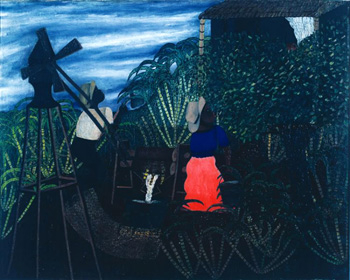
Prazeres primitive work titled Moendas took a prize
|
All these currents adopt as paradigms the art of madmen, savages and mediums and the improvisations of clowns and children. This explains how an award at the First Biennale of São Paulo (1951) was granted to Hector dos Prazeres, a complete illiterate in plastic arts.
In many of the vanguard artists, we find the influence of magic and the occult. We have shown that Kandinsky produced his works of art in state of trance. Herbert Read affirms that Picasso did the same with many of his paintings. (4)
Klee was inspired by the artistic works of the so-called primitive man (whom he confused with the savages of Polynesia and the Americas), as well as by the hallucinations of madmen. He used to paint in the state of hypnosis. Chirico painted his phantasmagoric landscapes with his eyes closed, also in state of trance. We have already described the theosophical links of one of the leaders of Abstractionism, the Dutch painter Piet Mondrian.
These facts alone should raise suspicions in Catholics about these early modern art currents since they clearly show the radical opposition of the basic principles of modern art with Catholic doctrine.
Nonetheless, we will present more examples for our readers.
Why do evolutionists want to return to the caveman?
Surrealist Automatism is a generalized technique without conscious self-censorship that struggles to return to the instincts of the primitive man.
At first glance, it seems to contradict the theory of evolution. In fact, partisans of this current present themselves as vanguard artists, the supporters of a perpetual evolution of mankind, who wish to cut all ties with the past. They go so far as to propose burning all the museums. These same super-modern artists adopt as foundation for their art a return to the mental state of the savage, the primitive caveman. How can this contradiction be explained?
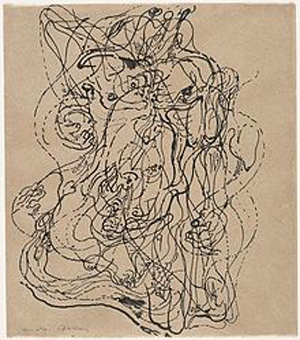
An automatic sketch by Andre Masson |
Osório Cesar tells us that the goal is to “liberate” mankind from Christianity and, following the Gnostic version of the Fall, to encourage the world to return to the ancient Gnosis (knowledge), or lost science, which receded when matter and spirit were united.
This Gnostic Pantheism intensely despises what it calls “moralism” and “asceticism,” the parts of Catholic doctrine turned toward taming our bad nature and subjecting it to the spirit. Any notion of culpability is foreign to the Gnostic system. For it, the notion of evil cannot reach the personal level. Evil supposedly is the result of a cosmic cataclysm that caused the spirit to be captured in and enslaved to matter. Thus, the more man descends into the world of his brutal senses, the closer he returns to that initial disaster and the freer he becomes from the corruption of matter. If he transcends matter in this backward process and enters that initial pure stage of the idea, he will be fully liberated.
Therefore, Abstractionism aims to make an artistic rendering of that initial and pure idea in the subliminal conscious of man. This helps to explain why the modern Gnostics place such emphasis on the return to the primitive man.
Catholic doctrine and history oppose Gnosis
According to Catholic teaching corroborated by true science, however, there is no primitive man or initial stage of savagery and barbarianism. God created man in His own image and likeness in a stage of integrity with the most brilliant possible intelligence. The first man lived in a state of original justice that granted his soul complete control over his body.
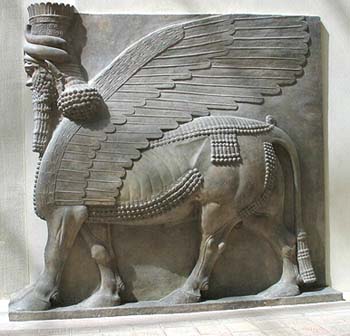
Archeological discoveries reveal refined ancient art, above an Assyrian sculpture
|
Therefore, man started out not guided by his instincts and deprived of a moral consciousness, but directed by the gifts of knowledge and wisdom. This is not just a matter of Faith. The testimonies and archeological discoveries from ancient civilizations likewise confirm that there was no caveman. To the contrary, the institutions and monuments of ancient men are expressions of a high level of intelligence and culture.
Contemporary savages, far from representing the initial primal man, represent only the psychological ruins of what man once was. In the Bororos Indians of Mato Grosso (Brazil), for instance, we see that the logic structure of their language remained as an expression of the elevated culture they once had and then abandoned. Today they exist only as the dilapidated remains of a much higher culture.
Only a few examples of the pre-Diluvium cultures have come down to us. But those vestiges do not support the thesis of the Fetishism and Primitivism defended by the mentors of modern art. Far from being guided by their instincts, the ancient man shows a great intellectual development. That is why Hippocrates said, “The arts were originally graces given to men by the gods.”
Modern art, another facet of the Revolution
In summary, modern art does not accept the teaching of the Catholic Church, strives for a return to Paganism, despises the dogma of the Original Fall, and thus cannot admit that man can be saved by the practice of the Commandments of the Law of God. It does not accept men as the damaged descendents of Adam and heirs of his guilt, but wants men to disobey their Creator and pretends to reach a paradisiacal knowledge by magical and occult means.
Enemies of the divine plan, members of the mystical body of the Devil - which is the opposite of the Mystical Body of Christ, the mentors of this satanic subversion have inverted the codes for purity and decadence. Psychoanalyst Neves Manta affirms: “Whoever imagines that the mentality of the vanguard is decadent reveals the great possible incomprehension. The vanguard man, like the child and the schizophrenic, is the individual who returns to pre-historic purity, renouncing the stupid modern prejudices, reacting against them through symbols.” (5)
The loss of the notion of sin is one the worst scourges of the modern world, according to the teaching of Pius XII. Modern art, as a system, aims precisely for that: the destruction of the very notion of sin.
We should not lose sight of the ensemble of the Revolution in its various fronts of attack against Christian Civilization and the Catholic Church. In the field of visual arts, we face one facet of that grand ensemble that is preparing in its secret laboratories with its multitude of theologians, philosophers, scientists, artists, politicians, sociologists, witches and warlocks the advent of the kingdom of the Devil.
1. Osorio Cesar, A arte dos loucos e dos artistas de vanguarda [The Art of madmen and vanguard artists], 1954.
2. Gaspar Simões, Vida e obra de Fernando Pessoa, 2nd ed., p. 234.
3. Oswaldo de Andrade, “A Marcha das Utopias,” in Estado de São Paulo, September 27, 1953.
4. Herbert Read, in the Journal of the Royal Society of Arts, January 18, 1946.
5. Neves Manta, Preface to A arte dos loucos e dos artistas de vanguarda.

Translated and adapted by TIA desk from
Catolicismo, n. 38, February 1954
Posted January 18, 2012

Related Topics of Interest
 The Modern Art's Kabala The Modern Art's Kabala
 A Sacred Art Possesed by the Devil A Sacred Art Possesed by the Devil
 Esoteric Characteristics of Modern Art Esoteric Characteristics of Modern Art
 Abstract Art & Theosophy Abstract Art & Theosophy
 Modern Art, Socialism & Marxism Modern Art, Socialism & Marxism
 Two Pictures, Two Mentalities, Two Doctrines Two Pictures, Two Mentalities, Two Doctrines
 Picasso Painted in a State of Trance Picasso Painted in a State of Trance
 Wojtyla Influenced by Theosophist Helena Blavatsky Wojtyla Influenced by Theosophist Helena Blavatsky

Related Works of Interest
|
|
Art & Architecture | Hot Topics | Home | Books | CDs | Search | Contact Us | Donate

© 2002-
Tradition in Action, Inc. All Rights Reserved
|
 |

|